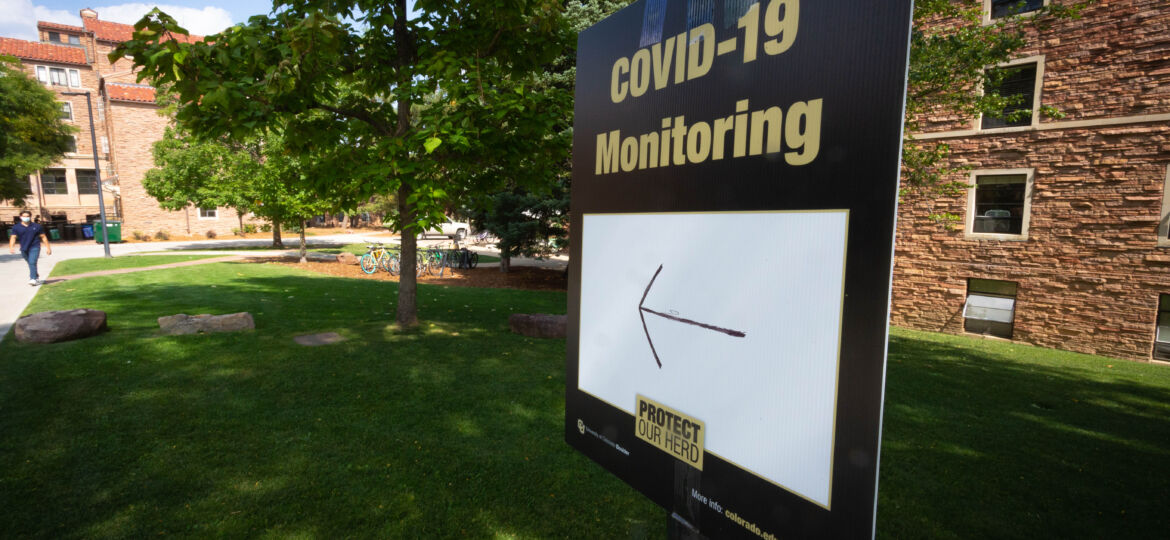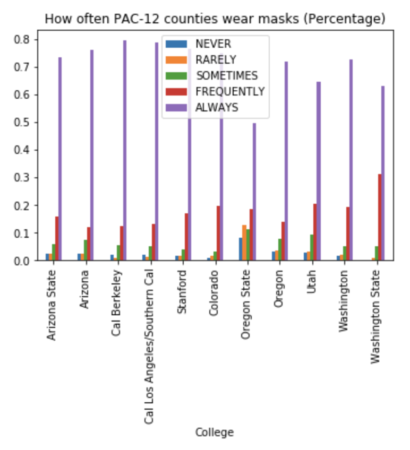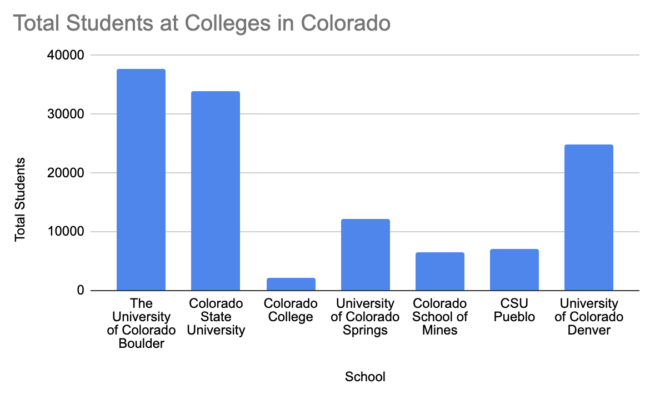
CU Boulder Ranks High Among Colorado Colleges for Positive COVID-19 Cases
By Steven Bonifazi, Caden Bradbury and Lauren Irwin
Nestled against the foothills of the Rocky Mountains, the City of Boulder is highly regarded by many. The city was chosen as the country’s top city to live in by the U.S. News & World Report’s annual Best Places to Live rankings, and named the top five healthiest counties to live in according to a 2019 report from Westword Magazine.
However, the coronavirus pandemic has forced itself into everyday life and changed everything for the city and especially the university that calls Boulder home.
The University of Colorado Boulder, disproportionality, has experienced one of the highest numbers of positive COVID-19 cases than any other college town within Colorado, along with Colorado State University in Fort Collins, Colorado.
Colleges and universities across the nation are hot spots for COVID-19, especially larger campuses. A total of 34,975 students enrolled for the fall 2020 semester at CU Boulder, while CSU saw a total of 27,835 students this year according to a BizWest article.
According to CU’s COVID-19-Ready Dashboard, from the beginning of the semester to the end, positive on-campus cases rose from three on Aug. 24 to 1,706 cases by Dec. 15. Out of the counties in Colorado, Boulder ranks eighth in COVID-19 cases with 12,154 as of Dec. 6.
CU Boulder’s positive case count comes second to its rival school CSU with 1,779 cases as of Friday, Dec. 18, topping CSU Pueblo at 932 cases.
Positive on-campus cases for select Colorado colleges, and the counties the schools are located in, as of Friday, Dec. 18, are as follows:
- CSU (Larimer County) – 1,779
- CU Boulder (Boulder County) – 1,706
- CSU Pueblo (Pueblo County) – 932
- Colorado College (El Paso County) – 491
- Colorado School of Mines (Jefferson County) – 401
- CU Colorado Springs (El Paso County) – 249
- CU Denver (Denver County) – 36

Due to a surge in positive COVID-19 cases linked to CU Boulder, the university decided to transition all classes to remote learning on Sept. 23, less than a month into the fall semester. A Colorado Sun article stated that over 750 people associated with CU Boulder tested positive for COVID-19 with 457 testing positive in just one week.
In response to the surge of cases, on Sept. 24, Boulder County Public Health issued a public health order banning 18 to 22-year-olds from gathering until Thursday, Oct. 8, to curb the spread. The city also recommended individuals should not congregate in common areas of their homes with roommates, encouraging isolation even in their own homes and neighborhoods. After students voiced concerns over the dangers of walking alone at night, as they were not permitted to congregate with anyone, the city lifted the one person congregation limit to two people.

According to Boulder County communications and marketing specialist Chana Goussetis, as of Nov. 19, the two-week positivity rate for Boulder County as a whole was 8.2% while the two-week positivity rate for 18 to 22-year-olds was 11.4%.
College campuses can have a large effect on not only the community but the entire country. Although young adults are less likely to reap serious consequences of the virus, it affects those they come in contact with from classmates and coworkers to friends and family members.
The traditional college experience has changed drastically. Many sports and live events have either been canceled or have limited seating. Classes have been staggered and taught either remotely or in a classroom with people socially distanced and wearing masks. Everyone’s health and safety are at risk.
Caden Bradbury is an information science senior at CU Boulder who analyzed college county data in 2020 concerning PAC-12 universities. In this data set, Bradbury’s findings show that communities that do not wear masks always or frequently have a higher percentage of their population contracting COVID-19.

“In Colorado’s cases, it seems that Boulder County has the best mask behavior of all PAC-12 schools,” said Bradbury. “Our mask-wearing behavior suggests that we should also have the least amount of cases. This means that something is causing our rates, besides mask-wearing.”
Although CU Boulder urges mask-wearing more than any other preventative measure, the failure to do so is not what is causing the high number of positive on-campus cases. The Colorado State Joint Information Center has stated factors that play into case numbers are the amount of disease circulating in a community, behaviors of members of a community, testing availability and case reports.
For Lilly Trapp, a junior Leed’s School of Business student at CU Boulder, she did everything by the book to have a safe and successful semester.
Working at her apartment complex’s front desk at UClub on 28th, Trapp contracted COVID-19 in early September before the city regulations were mandated. Wardenburg, CU Boulder’s Health Center, provides COVID-19 testing for CU students, and Trapp says the self-administered testing process made her wary of accurate results.
“At first they sent a video of how to take the test for Wardenburg, but I was a little worried that I wouldn’t know what I was doing,” said Trapp. To her ease, once she was at the testing station, the nurses guided her through the process – remove the nasal swab from the wrapper, swab nose for 10 seconds on each side and put the swab in the tube. But what she wasn’t prepared for was the positive result.
University communication about COVID-19 procedures was straightforward, Trapp said, but what was she to do in an emergency? Her building had a fire alarm go off after she received a positive test. Should she stay or go?
Trapp ultimately “double-masked” and kept her distance from other students. No one ever told her what to do in a situation like that, she said. Trapp said this confusion and the loneliness of being quarantined in her bedroom were the hardest parts about contracting a positive test result.

Claire Calcaterra, a senior studying ecology and evolutionary biology and on track to be a pre-nursing graduate in the spring, decided to get COVID-19 tests often, as she works for a woman with multiple sclerosis. After several spit and nasal tests at Wardenburg Health Center, Calcaterra was turned away from getting tested, as she wasn’t exposed to someone with a positive test result within the past seven days, which was a requirement to get tested at the university’s medical center.
CU’s Wardenburg conducts nasal tests for COVID-19 while the Sara Sawyer Lab has a rapid spit test that can return results within 45 minutes. When students do not undergo testing at Wardenburg, the numbers are not accounted for and then become part of the larger Boulder statistics rather than CU itself.

While this was frustrating, Calcaterra and other students had to lie about exposure, just to get a free test. She said being turned away affected her work schedule and mental health.
“I would like to know if I have COVID-19 and it’s just frustrating that it’s not easy to get it from the university I am paying a lot of money to go to,” Calcaterra said.
Adding onto Calcaterra’s frustration, the university canceled its May 2021 commencement ceremony during finals week this December.
“When I heard that, I was really angry and it was hard to care about finishing my classes when in the back of my head I knew I wasn’t going to be rewarded for it later,” Calcaterra said. “Things moved fast this year, the vaccine just came out, who knows what it might look like in May.”
Students like Calcaterra and her roommates were frustrated with the lack of authentic communication from CU Boulder. Without following up with genuine actions, the emails were empty promises and confusing communication, Calcaterra said.
“They would send out emails saying that they supported us, but I didn’t really feel like that was supported throughout the whole thing,” Calcaterra said. “I feel like they were saying one thing and then doing another.”
So the question remains if CU students are wearing masks and staying socially distanced, what is causing the numbers of positive cases to rise?
Officials like Marc Stine, CU Greek Advocate at the independent Interfraternity Council (IFC) on University Hill in Boulder, believe the high numbers of cases at CU Boulder are due to a higher number of students.
“The issue is not how many cases there are, it is how many cases per capita,” said Stine. “There are more sorority people in Boulder than there are students at the University of Denver.”

Since the implementation of statewide public health orders and restrictions, the IFC has not put in place any rules or regulations concerning reducing the severity of COVID-19. According to Stine, the IFC does not need to write any rules regarding mitigation as their one rule has been to follow the guidelines and instructions of CU Boulder, city and state health departments and police departments.

Like the majority of facets and aspects of life, Greek life has also been affected by the pandemic. Greek houses typically have more than 10 people living together per house, which increases the likelihood of the spread of COVID-19. Greek life can also have a significant impact on COVID-19 cases due to the social aspect which often elicits gatherings, which officials would define as parties.
CU Panhellenic Council, which is an umbrella organization for 10 National Panhellenic Conference (NPC) sororities and three associate members chartered at CU, have put procedures in place to ensure the safety and health of the community and their members.
“As Panhellenic women, we value our members and the greater community and want to keep everyone healthy and safe,” said Kenzie Hardt, CU Boulder Panhellenic President. “With this in mind, we joined forces with CU IFC and Multicultural Greek Council (MGC) to create a joint statement to our members and the greater community.”
Alongside Hardt, CU-IFC President Conner Freiboth and MGC President Vanessa Guereca released a statement with guidelines and procedures regarding mitigating COVID-19 to CU IFC, MGC and their members which are as follows:
“At this time, all councils discourage any form of in-person events (i.e. parties, date dashes, brother/sisterhood events, chapter meetings, etc.). We expect each of our community members to abide by CU Boulder protocols, local and state ordinances, as well as the procedures put into place by both your local and national chapter organizations. These are including, but not limited to:
- Wearing a mask when you are on campus indoors & outdoors.
- Limiting all social gatherings to 10 people or less, while still abiding by social distancing practices (i.e. wearing a mask and remaining 6-feet apart).
- Practicing social distancing even when in casual environments (ex. lawns, courtyards, porches, etc.).”
Those who did not comply with these practices faced consequences based on the jurisdiction of their respective council. Stine states there were a couple of fraternities under stay at home order due to previous violations and that if they blatantly broke the rules that they were subject to judicial board hearings and could even be sanctioned by the IFC. He also stated that the president of IFC put out a statement that said the first violation is a $10 fine per fraternity brother, the second violation is a $25 fine and the third being a $35 fine per individual.
Although Greek students and others who violate rules surrounding COVID-19 are being dealt with, the university is continuing to make adjustments aimed at extenuating positive cases.
CU Boulder announced that the spring 2021 semester will take place remotely beginning on Thursday, Jan. 14 and continue for at least for the first month due to national and state COVID-19 projections. With a surge in cases following Thanksgiving, it is estimated that there could be a similar spike as Christmas and New Years’ approaches.
As the university recognized surges in cases around holidays and traveling, CU Boulder intends to resume in-person courses on Monday, Feb. 15, which is also when freshmen will be allowed to move back into the dormitories.
While the university is currently making efforts to make certain that positive cases will not increase, the county is currently under level red: severe risk regarding the state’s COVID-19 dial. This prevents personal gatherings of any size, prioritizes staying at home and working remotely and suggests remote and limited in-person learning when necessary for higher education.
“I do not know what we are going to be able to do starting the second semester if we are still at code red,” said Stine.

